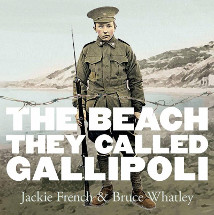The beach they called Gallipoli by Jackie French and Bruce Whatley

HarperCollins, 2014. ISBN 9780732292263
(Age: 8+) Highly recommended. World War One, Gallipoli, War,
Environment. Kitted out with army uniform, great boots and a
bayoneted rifle, fifteen year old Alec Campbell stares out at the
reader from the front cover of Jackie French's latest picture book.
People who have read about this war will know that he was one of the
underage boys who enlisted, but unlike many others, he survived.
Reading this book the reader can only wonder how anyone survived
this particular battlefield.
Each page has French's brief words, encapsulating what happened at
Gallipoli on the dates highlighted. Pared down to sentences,
phrases, and sometimes single words, these give an account of the
events that occurred on this beach and in its hills. The background,
first appearing on the cover, of the low hills of Gallipoli beach,
begins with the villagers who fished there prior to the outbreak of
war. Their use of the sea and the beach is in stark contrast with
what happened only a few months later, when thousands of soldiers
were landed with orders to take the high ground where the Turkish
Army waited.
On each page, Whatley has a drawing of the scene in the top left
hand corner, then drawings and photographs on what appears to be
torn paper, underlining the transient nature of the engagement. The
mix of different media, makes the reader search out each picture,
taking in the detail and the message underpinned by the image. Maps,
artifacts, images of dead soldiers, munition, trenches, headstones,
animals and barbed wire cover the pages, leaving readers in no doubt
about the changes made to this little beach. French takes us forward
to the beach today, a place of rest for the nearly nine thousand
Australians killed (and 80,000 Turks, 44,000 Allies, 2,700 New
Zealanders), a site of pilgrimage for many, a place where everyone
can reflect upon the utter futility of war.
Fran Knight